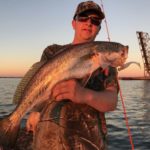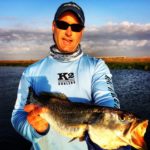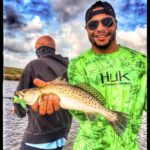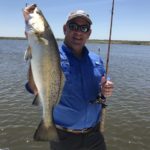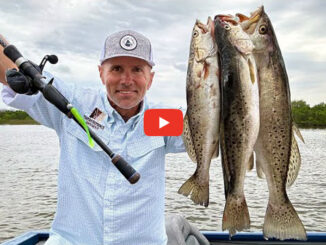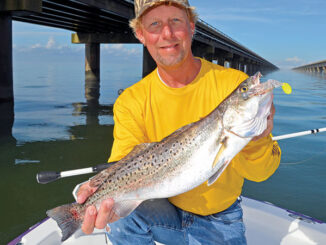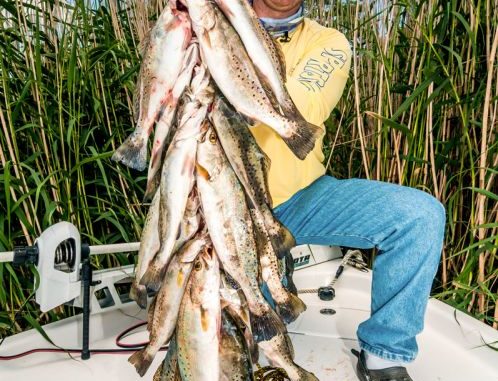
If your freezer is lacking speck fillets, theses are the three places you need to visit this spring — with local guides sharing tactics on how to put meat in the box.
This winter has been miserable, with frigid temperatures putting speckled trout all along the coast into lethargic moods.
Sure, redfish took up the slack, but let’s face it: Speckled trout eat far better than reds.
So the spring warmup is a welcome change, finally pulling specks out of their winter holes to start feasting on bait that begins pouring into the marshes this month.
Unlike other coastal states, Louisiana offers amazing options. From the Mississippi state line west to Texas, trout simply swarm the fertile waters.
That means with the probable exception of Cypremort Point and possibly the mouth of the Mississippi, both of which are at the whim of the rivers that dominate those areas, anglers can find good options anywhere there’s a bit of salt in the water.
But why settle for good when you can up your odds by targeting the very best of the state’s trout fishing locales?
To that end, we reached out to guides in the three fisheries that offer optimal opportunities to trout fishermen this spring.
Here’s what they had to say about how you can load the boat early and often:
Lake Pontchartrain
If you haven’t fished Lake Pontchartrain, it’s likely to test your trout-catching skills. It can be difficult. Tough. Absolutely maddening.
But it’s also packed with fish — and plenty of them top the school trout classification.
And now is when you need to launch your boat.
“April and May are two of the prime months,” said Matrix Shad’s Chas Champagne, who spends as much time as possible fishing the huge lake.
There are some shoreline areas that will hold fish, and artificial reefs are definitely places to be looked at.
However, the main attractions are the bridges: the Interstate 10 Twin Spans, the Highway 11 bridge, the Trestles train bridge and the Causeway.
If you want the best opportunity, Champagne said there is a clear winner.
“The Trestles is, by far, the most consistent of the bridges,” he said.
Each bridge, however, holds big fish. And each fishes a little different, so you have to be ready to adjust.
For instance, the Causeway and Highway 11 offer anglers the ability to catch fish from beneath the spans.
Champagne said the key on these spans is to cast between the pilings and work back to the boat, ensuring your jig reaches the bottom and works right next to the bridge supports.
“On the Causeway and Highway 11, you are not going to catch a fish if you aren’t grazing those pilings,” he explained. “So casting accuracy is critical.”
The bottom beneath the Trestles, on the other hand, is not friendly to anglers.
“The Trestles is full of snags, so if you throw under it you’ll go through 2,000 jigheads in a day,” Champagne said. “So you want to back off with your trolling motor about a cast away (from the bridge) and throw at the pilings. You’ll notice the fish are going to be tight to the pilings or way off.”
If you’re after the huge trout for which the lake is known, pounding the Highway 11 span is your best bet.
“Every 7-pounder or better I’ve caught has come off the Highway 11 bridge,” Champagne said.
The biggest challenge Lake Pontchartrain newbies face is the difference between fishing other coastal waters and this huge body of water.
“You have to understand how to fish deep water,” Champagne said. “South Louisiana anglers are so used to fishing 2- to 6-foot water, where they can fish topwaters and stuff like that. That’s not going to cut it in (Lake Pontchartrain).
“You’re fishing water that is 10 to 20 feet (deep), depending on the bridge and location. You need to be good at deep-water fishing.”
Add to that impacts of wind and current, and the result is a steep learning curve.
But it’s worth putting in the time to figuring it all out.
Champagne said he never turns away from plastics, but definitely leaves the popping corks at home.
Instead, this is a tightline game, with heavy jigs (⅜ to ½ ounce) being the best bets because it allows anglers to overcome current and reach the bottom, where big trout live.
However, Champagne admitted live shrimp can be deadly. And now, thanks to changes in Louisiana laws, marinas can legally sell live bait year round, so anglers can find live shrimp in April and May — even though the crustaceans don’t naturally enter the lake until at least May.
If you decide to go that route, Carolina rigs and drop shots work. But Champagne said another tactic can be even better.
“A sliding cork is really good,” he said. “You can just open the bail and let the current pull the (shrimp) along. It’s allowing you to cover more water. And it just looks natural in the water.”
Dularge & Cocodrie
Perhaps the most-consistent trout fishery in the state right now is shared by anglers launching from Dularge and Cocodrie. There are just innumerable specks there swimming in the lakes, bayous and nearshore waters.
And the spring provides something for everyone — whether you want to stay close to the launch or head farther south to pick fish off the beaches and wellheads bordering the Gulf of Mexico.
“Usually shrimp are in the interior lakes,” Capt. Marty LaCoste of Absolute Fishing Charters said. “So there are trout in the lakes, but fish are actually starting to move offshore, too, to the beaches.”
LaCoste said speckled trout teem in the larger interior lakes like Lake Mechant, Sister Lake and Lost Lake.
“Those are the three main lakes,” he said.
Plastics are his go-to for these areas.
“Inside, I would never, ever have any live bait,” LaCoste said. “You just don’t need it.”
A two-pronged attack provides plenty of opportunities for box-filling frenzies when staying close in.
Diving birds often signal schools of trout, which can quickly turn into limits of fish swinging onboard.
LaCoste said he carefully eases into attack position.
“I’ll come up upwind and stop a couple hundred yards away,” LaCoste said. “I’ll use the trolling motor, wind and current to pull in closer.”
But this veteran guide said he sometimes just uses Mother Nature to save time — particularly when he has trouble finding willing keepers under the birds.
“Sometimes you pull up to a flock of birds and catch one or two fish,” LaCoste said. “If I’ve pulled up to a couple of flocks and only caught five or six (trout), then I’ll get to where I don’t put my trolling motor down.
“I’ll just use the wind and current to drift in.”
As he pulls into the birds’ feeding frenzy, he makes several casts, but doesn’t waste a lot of time before moving to the next flock.
Reefs in these areas also can hold fish, and LaCoste said he approaches them the same as picking birds.
The beauty of this time of year is that interior speckled trout aren’t the dinks often found in the summer.
“Some years we can catch good trout, too, up until mid-May,” LaCoste said.
By the first of May, LaCoste said he’ll be making forays south. While there will still be plenty of keepers in the interior lakes, this is when many anglers in the know head to the beaches of West Timbalier, Last Island and Coon Point to find swarms of yellowmouths.
Trout pull to nearshore platforms and reefs, but the beaches are better options when winds plague the coast — which is often the case in the spring.
“It’s usually windy, and the beaches will give you some protection,” LaCoste said. “If it’s a 20 mph north wind, I’m not even going out there, but a 20 mph south wind we can find protection.”
He said the beaches offer a lot of options.
“There’s reefs on all of these beaches,” LaCoste said. “There are wellheads, points. You just move until you find the fish.”
This is when LaCoste stocks up on live shrimp before leaving the dock.
“The fish (on the beaches) just quit hitting plastics because the majority of boats going out there from Cocodrie are using live shrimp,” he explained. “The plastic bite comes to a halt, and you have to fish live bait.”
That’s not to say live shrimp are his preferred means of catching these trout.
“I’m going to fish plastics first,” LaCoste said. “There are days we catch them all on plastics and don’t use live shrimp.
“But if we don’t catch them on plastics, we’ll turn to the live shrimp. For me, it’s insurance.”
Calcasieu Lake
Any Top 3 list would be worthless if it didn’t include Big Lake, which has a storied history of producing lunker trout.
And, even though the last few years have been a little off because of high rainfall, April is when things really begin heating up.
“In the winter and into the early part of the year, a lot of the fish are up the system,” Calcasieu Charter Service’s Erik Rue said. “As the temperatures start to come up and you get some shrimp coming into the lower end of the system, the big fish start moving down.”
That’s when the reefs and hard banks on the south end of the Calcasieu Lake traditionally load up with trout that give anglers weak knees.
Some of that habitat is gone now, thanks to erosion and oystering operations, but Rue said there are still plenty of fish to be caught.
“West Cove is still a real hotspot,” he said. “Most of that is still intact.”
No matter where you look, the biggest key to success is finding the groceries on which trout feed.
“In general, you want to find the bait,” Rue explained. “Find the shrimp and the largest concentrations of mullet, and then target those reefs and shorelines that are traditionally good spots — that’s what you’re going to find trout.”
While some anglers love live bait, Rue said it’s not really necessary. He sticks mainly with plastics and twitch baits.
“Those twitch baits like the MirrOdine — there are times when they are lights out,” Rue said. “You’re catching a fish here and there with plastics, and then you throw out a twitch bait and catch them on every cast.”
Rue said he’s transitioned his operations away from trophy trout fishing, so his bread and butter business relies on soft-plastic lures.
But he’s not one of those who swears by lightweight jigs, although there’s a reason he has upsized from ¼- to ⅜-ounce jigheads.
“A couple of years back, I started using braid, and I’m sold on it,” Rue said. “I don’t use anything else.”
He adds a 4- to 6-foot 25-pound mono leader, with Berkley Big Game being his go-to material.
And he tops off his rig with a Norton Bull Minnow.
This combination performs largely like other plastics fished on lighter weights.
“The Bull Minnows are kind of big, buoyant baits, and with that 25-pound Big Game, I don’t think my ⅜-ounce jighead sinks any faster than those other guys fishing with light jigheads (and smaller plastics),” Rue explained.
No matter if you go with Rue’s setup or stick with lighter terminal tackle, it’s critical to let the bait settle before beginning the retrieve.
“I like to be in constant contact with the bottom,” Rue said. “I want to know when a fish hits it.”
The exact retrieve changes from day to day, however.
“Some days you get there and the fish are up on the surface, and when the bait hits the water you get a bite,” Rue said. “On other days, you have to drag it along the bottom.
“You’ve just got to figure it out.”

